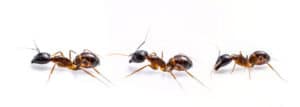Ants
Ants: Knowing is Half the Battle
Ants are an ever-present nuisance pest that can be found almost anywhere in the world. That’s due to their remarkable adaptability and social structures. They are organized, persistent, and methodical in their mission to grow their colonies. The bad news: They have no issue invading homes in large numbers to get what they want. The good news? All Solutions Pest Control is here to help you keep them out.
Our local pest control professionals have been trained extensively in identifying different species of ants. We can track down their colonies, and root them out at the source. And we can recognize the differences in appearance and behavior between different ant species. Which can mean the difference between a relatively simple fix, and a seemingly never-ending battle for control.

Odorous House Ants are fully capable of surviving outdoors, as they have adapted to be quite resistant to extreme temperatures. They can commonly be found making shallow nests under boards and stones. However, while capable of ‘roughing it’, these ants show a strong preference for nesting indoors in warm, moist spaces. Such as in kitchens and bathrooms near sinks, utility closets, laundry rooms, and basements with sump-pumps. With preferences like these, it’s no wonder why the Odorous House Ant is the most common ant found in structures in Missouri.
Once a nest is established in a home (usually within exterior walls near water sources), the colony spreads throughout the house to forage for resources, seeking out sugary foods to bring back to the nest. These colonies can easily spread throughout the house like wildfire, and quickly infest vast areas of wall space. This can possibly necessitate multiple specialized pest control treatments to completely eliminate the colony.
If you believe you’ve fallen victim to these smelly squatters, don’t wait; call to schedule an appointment with All Solutions Pest Control today, before things get out of hand.
Pavement ants are also particularly territorial, and can often be observed battling with competing colonies on sidewalks and other paved surfaces, often creating piles of hundreds of dead ants. Possibly their most recognizable ‘calling card’, Pavement Ants also create small crater-like hills of sand around their nest’s entrance holes.
While they are outdoorsmen at heart, these opportunistic pests will still occasionally invade homes to forage for foods rich in protein, sugar, and starch. Once these resources are found, the ants will lay down scent trails and call in the rest of the family to help transport the food back to their nest.
Worried about a potential outbreak of these pesky blacktop bugs? Give All Solutions Pest Control a call today- We’ll kick em’ to the curb.
Once inside a structure, Pharaoh ants waste no time setting up multiple colonies throughout the building, sometimes establishing multiple colonies in the same room. Large colonies can create dozens, if not hundreds of reproductive females.
Easily identifiable by their orange-yellowish coloration, Pharaoh Ants do not typically form nests outdoors, as they prefer to live and forage in warm, moist indoor environments. They also exhibit peculiar nesting habits, and have been observed creating nests between pieces of stationery and between layers of bedsheets. These pervasive pests are attracted to grease, meats, insects, and sweets, and are infamously adept in their ability to get into things- things like refrigerators, pantries, bags, boxes, and waste bins… and that’s just in residential homes.
Some of these nasty nuisances have also been known to infest office buildings, factories, bakeries, restaurants, and even hospitals. This behavior is especially dangerous to immune-compromised individuals, as Pharaoh ants can carry a number of different pathogens, including Streptococcus, Staphylococcus, and Salmonella.
If you’re seeing Pharaoh Ants in your home, the last thing you want to do is wait. Call All Solutions Pest Control to schedule an appointment today.
Habits
Prevention and Tips

Making adjustments to the home to make it less permeable to ants is a great way to reduce their presence. This includes caulking wall penetrations like phone and utility lines and tightening window and door frames.
Remove any stray wood (firewood, mulch beds, boards) that is near the house, and trim any shrubbery that has grown too close to the house.
Preventing excess moisture from accumulating in the structure of your home will make it overall less hospitable to ants, thus discouraging them from nesting there.
Cleaning counters and tabletops where food has been prepared and eaten, along with storing food in properly sealed containers, will discourage ants from entering your home in search of food. Properly sealing garbage bags and frequently cleaning larger trash bins can also prevent ants from being attracted to the food waste in your garbage.
Get a Free Estimate!
Request A Quote Today
...
Contact Us
Location :
44 Jason Ct, St Charles, MO 63304